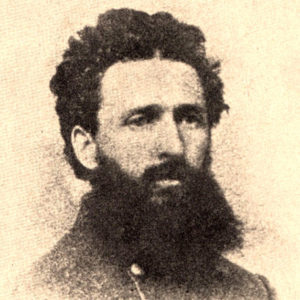calsfoundation@cals.org
Nicholas Bartlett Pearce (1828–1894)
Nicholas Bartlett Pearce commanded the First (western) Division of the Arkansas Army in the Battle of Wilson’s Creek (Oak Hills) on August 10, 1861, and served subsequently as a Confederate commissary officer.
Nicholas Bartlett Pearce was born on July 20, 1828, in Princeton, Kentucky, to farmers Allen Pearce and Mary (Polly) Morse Pearce; he had four sisters and one brother. He reportedly graduated from Cumberland College in 1845 and then attended the U.S. Military Academy at West Point, New York, graduating in the class of 1850, ranking twenty-sixth in a class of forty-four. Entering the service as a second lieutenant, he saw service in Texas and Utah and, in June 1855, while stationed at Fort Smith (Sebastian County), married Nancy Katherine “Nannie” Smith. (Smith’s name appears in various sources as Naomie, Nancy, Nancie, and Nannie.) The couple had six children who lived past infancy.
In 1858, Pearce resigned his commission and went into business with his father-in-law, who kept a general store and had a mill on Little Osage Creek at Osage Mills (Benton County). He was also made colonel in the state militia. Though an opponent of secession, Pearce was appointed brigadier general by the Arkansas Secession Convention in May 1861 and was assigned to command the First Division of the Arkansas Army. Secessionists attacked his record, and Governor Henry Massie Rector initially refused to accept his resignation from the state militia.
In July, in response to an appeal from Missouri State Guard commander General Sterling Price, and in conjunction with Confederate Indian Territory commander General Ben McCulloch, Pearce took his army into Missouri, where the allied armies were attacked on August 10 by the Union forces commanded by General Nathaniel Lyon. Brigadier General Pearce seems to have distinguished himself in the Battle of Wilson’s Creek (Oak Hills), but his decision to supply Arkansas muskets to Price’s unarmed Missouri volunteers subsequently generated criticism. After the battle, Pearce took his victorious army back to Arkansas. As plans to transfer the troops directly into the Confederacy had been sabotaged by a majority on the state’s Military Board, all but eighteen of the men voted to disband. Pearce seems to have made no effort to get a Confederate commission and later became a major in the commissary department. In this capacity, he played a major role in the conflict that arose in 1862 when General Thomas C. Hindman attempted to exert control over General Albert Pike. The struggle included a war of words between Pearce and Pike’s commissary officer, Major William M. Quesenbury. Charges of fraud and profiteering continued as Pearce later served in Texas, where he was chief quartermaster at San Antonio and a member of the Texas Military Board.
At the war’s end, Pearce obtained a pardon from President Andrew Johnson and rebuilt Osage Mills, which had been burned during the conflict. He served as the community’s postmaster in 1873. From 1872 to 1874, he was professor of mathematics and engineering at Arkansas Industrial University, now the University of Arkansas (UA) in Fayetteville (Washington County).
The overthrow of the Republicans in 1874 opened the door to ex-Confederates. Pearce served as clerk at the constitutional convention of 1874 and then as journal clerk of the state House of Representatives. In 1876, he sought the office of secretary of state and had the approval of many newspapers, including the Arkansas Gazette, with editor William Woodruff Jr. writing, “[N]o name on the ticket we will support with more pleasure than his.” However, at the state party convention, B. B. Beavers won on the second ballot.
Pearce next served on the Fish Commission, which was charged with bringing in new varieties of fish and protecting those already here. Shad, carp, and California salmon were, according to U.S. fish commissioner S. V. Baird, the only fish in question suitable for introduction, and some 80,000 shad were dumped into the White River at Newport (Jackson County) in 1876. In 1878, Pearce ran unsuccessfully for state land commissioner. Thereafter, he worked at a Kansas City wholesale house and moved to Whitesboro, Texas, in hopes of improving his wife’s health. He remained in Texas and worked as an expert land examiner for Lombard Investment. His wife died on October 3, 1885.
Pearce returned to Arkansas in 1891 to attend a Confederate reunion, and he authored an account of his battle experiences. In 1892, Osage Mills, then being run by his son Bart, was washed away in a flood. Pearce died on March 8, 1894, in Dallas, Texas, at the home of his daughter Mary Choice, and he was buried beside his wife at Whitesboro, Texas.
Pearce has always been an enigmatic figure in Arkansas history. While reportedly he had some local popularity, he had no close political ties to the region’s leaders. There was some mention in 1862 of his running for governor, but he refused the opportunity. While many militia officers disappeared once real fighting started, Pearce acted effectively in his only battle. He seems to have taken no role in Reconstruction or post-Reconstruction politics. “He was a true friend to his friends…loved them all,” his Sentinel obituary noted, adding, “He had but few enemies.” The Arkansas Gazette did not mention his passing.
For additional information:
Allardice, Bruce S. More Generals in Gray. Baton Rouge: Louisiana State University Press, 1995.
“General Pearce Dead.” Arkansas Sentinel (Fayetteville). March 20, 1894, p. 2.
Pearce, N. B. “Arkansas Troops in the Battle of Wilson’s Creek.” In Battles and Leaders of the Civil War, Vol. 1. New York: The Century Co., 1887.
Smith, M. Aldridge. “Nicholas Bartlett Pearce and the ‘Clamor of Command’ in Benton County during the War of the Rebellion.” Benton County Pioneer 30 (Fall 1985): 33–39.
Michael B. Dougan
Jonesboro, Arkansas
 Arkansas State Troops (CS)
Arkansas State Troops (CS) Democratic Party
Democratic Party Military
Military Nicholas Pearce
Nicholas Pearce 




Comments
No comments on this entry yet.